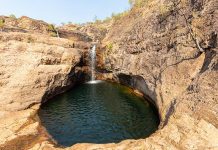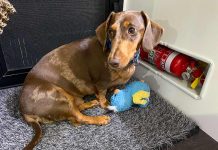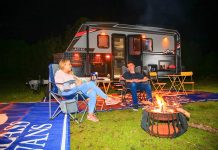Let me set the scene. We have just left Daly Waters and are driving north along the Stuart Highway, through the centre of Australia towards Mataranka and those welcoming hot springs. We’re seasoned road-trippers. Or so we thought.
This is our second half-lap of Australia. We’re driving from Adelaide to Darwin, then heading east to follow the coast back to South Australia. Today’s drive is only 168km – an easy stretch in outback terms – but things go terribly wrong when we stop at a tourist site.
We pull into the World War II No 45 Hospital historic site, NT. Well, that’s where we thought we were. But the historic site is not obvious at first. It’s a small area to pull into, with an obvious circular track where people have turned around again and left.
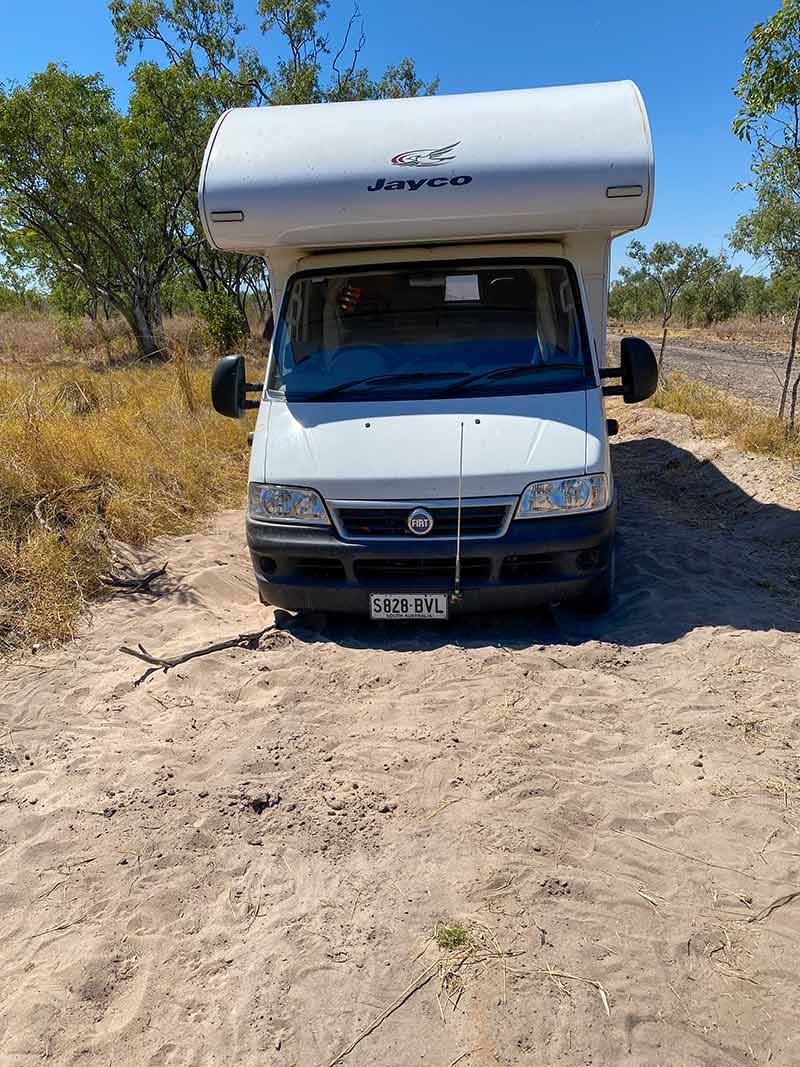
But there is a good, wide dirt road leading off to the right. That’s where the historic site must be. So we follow it.
Rick and I don’t go offroad in our trusty old 2006 Jayco motorhome. At 7.2m long, 2.5m wide and 3.4m tall, it’s big and heavy, and we’ve done enough kilometres to know it’s not suitable for most dirt roads. But this is a good, solid track.
Until it isn’t.
About 500m in, I get an uneasy feeling. Where is this old hospital? To the left is a barbed wire fence and a fire track – typical of many properties in Northern Territory. On the right is an embankment and thick scrub. There’s nowhere to turn around, even if we want to.
About 1km down the track, I’m sweating – more than I already was in the outback heat. Rick’s looking a little uneasy and muttering, “Where have you taken me now?”
The road is disintegrating into a goat track. It’s narrowed and we’re still trapped between the fence and embankment. Why not just reverse out? Good question. But by the time we have thought that might be a good idea, the hard surface has all but disappeared, replaced by big patches of soft sand. Not great when you’re in our heavy beast. And still no sight of the historic hospital site – or anywhere to turn around.
We are longer than the track is wide. So, we plough on. About 8km into our bumpy jaunt, we spot a section that we might be able to mount to turn around. As we slow ever so slightly to look closer, we realise our mistake. It’s black sand and we sink.
HARD NOT TO PANIC
You know those movies where ridiculously unsuspecting explorers suddenly fall into a pond of quicksand? That’s what it feels like to us. It’s hard not to panic (and swear). What do we do?
We channel the Leyland Brothers or, in our case, TV’s bumbling Russell Coight, and decide to dig ourselves out. There’s really no other option. We know now that there is no historic WWII hospital site anywhere near us so there will be no traffic heading our way.
Out comes our tiny fold-up camping spade. It’s embarrassingly inept, meant for outback ‘bogs’ of an entirely different kind. Our plastic levelling blocks are just about as useless in providing traction to drive out of our hole.
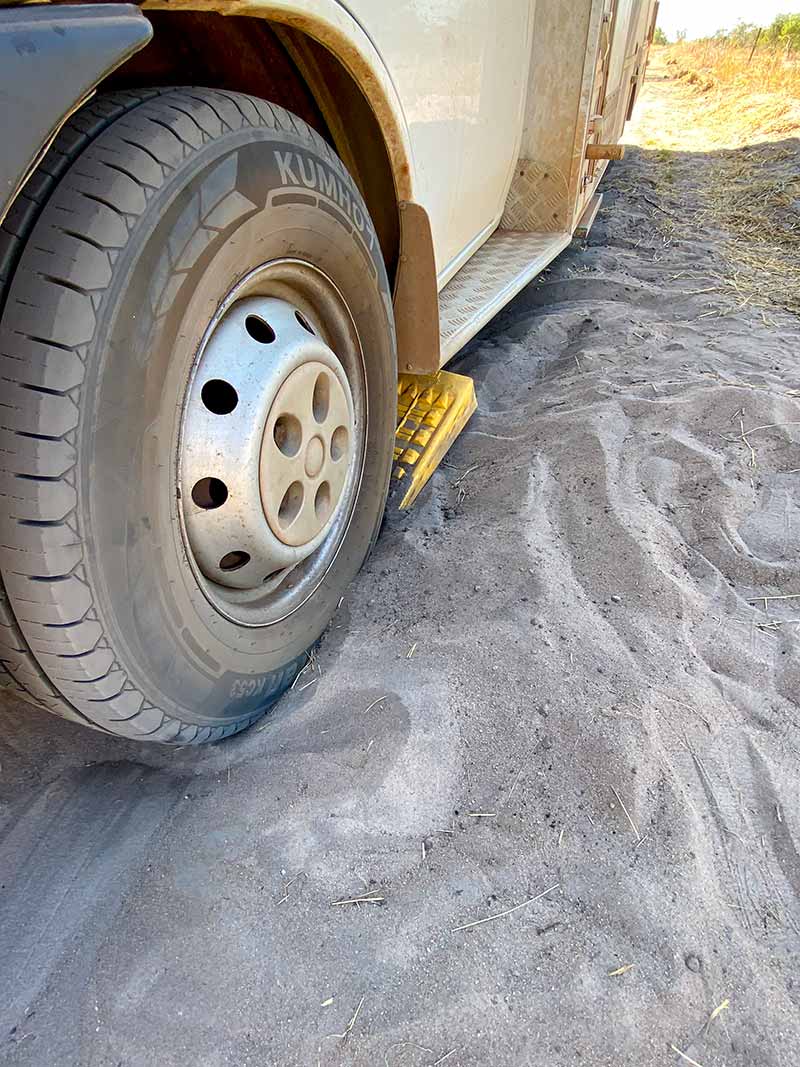 So we go hunting for wood in the long grass that I swore I would not be caught dead rummaging around in. But the threat of snakes feels like the lesser of two evils right now.
So we go hunting for wood in the long grass that I swore I would not be caught dead rummaging around in. But the threat of snakes feels like the lesser of two evils right now.
Rick almost wets his pants laughing at the little sticks I place neatly behind one wheel. Not much traction to be gained there. Mind you, his contribution is not much better, and I can blame my shortcomings on recent ankle surgery.
No amount of digging is working. We’re just sinking further, and attacking wasps force a retreat inside the motorhome.
We’ll have to call for help. Since we have no phone reception, the CB radio is looking good. Until it’s not. There’s no-one out there listening.
If I had a personal locator beacon, I could have set it off. But is it really that kind of emergency? I’m not ready to call in the troops yet.
LESSON 1
SOS calls work with no phone reception
We may not be able to call anyone out here, but we do have the SOS option on our mobile phones. In case you don’t know where it is, an SOS emergency slide option shows on the home screen when you go to power off your phone.
Will that work all the way out here? Especially if we don’t have reception? It can’t hurt to try.
Within seconds, Telstra is on the end of the line and it’s the best reception I think I’ve ever heard.
“Police, fire or ambulance?” they ask.
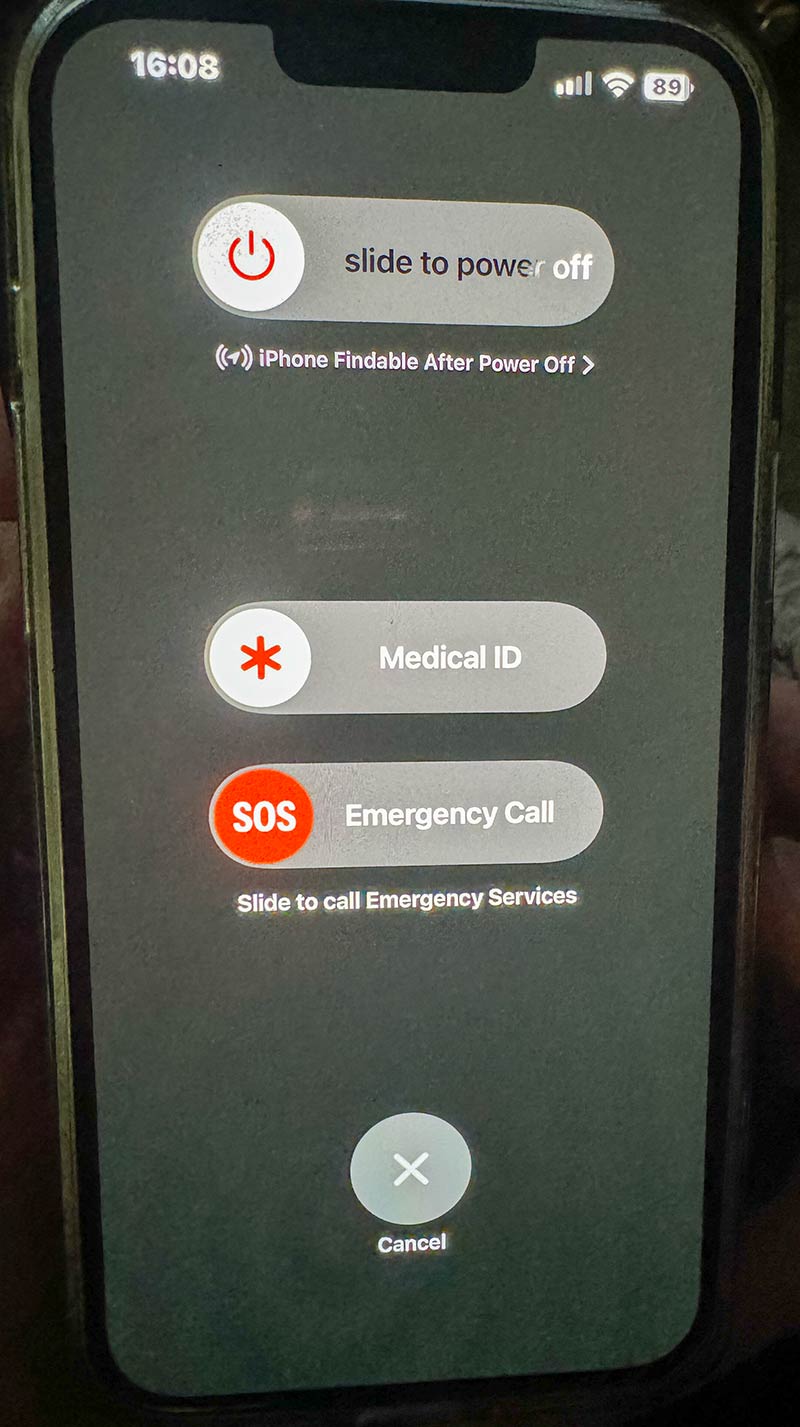
Rick starts telling our whole sorry tale. They don’t want to know.
“Police, fire or ambulance,” they repeat.
Police, we guess.
“Where are you?” they ask.
“Well, we don’t know exactly…” Rick starts trying to explain where we’ve gone wrong. They don’t want to know.
“Closest town?” the slightly annoyed operator asks.
We guessed Larrimah.
He puts us through to the Northern Territory Police. And so starts our recovery story.
I can’t stress how relieved we are to be talking to someone who might be able to help us. A lovely woman takes our details.
She calmed us and helped ‘find’ us. We knew where we had turned off – or where we thought we had turned off – but the goat track we ended up on was an unknown.
LESSON 2
You can find your exact location – without reception
Here’s the next bit of gold we discovered. Even without phone reception or internet, Google Maps cap pinpoint your exact location with latitude and longitude points.
With all our details sorted, we are put through to the supervisor, Sergeant George at NT Police. He’s our new best friend.
“I’m going to help you,” Sgt George says. “Just let me make a few calls. You’ll have to call me back in half an hour.”
We’re not sure why they can’t call us back, but the emergency line doesn’t work that way, we’re told. It’s a long 30 minutes.
Then we call back via the same rigmarole. We swipe right on the SOS phone option and get, “Police, fire or ambulance?”
“Police please.”
“What state and town?”
“NT. We’re stuck out on this track…”
They don’t want to know.
“What town?”
“Larrimah. We think.”
Sgt George has good and bad news. Bad news first.
LESSON 3
Roadside assistance doesn’t cover getting bogged
AANT (the NT equivalent to RAA in South Australia or RACV in Victoria, etc.) doesn’t want to know about people getting bogged.
“They won’t help,” Sgt George says.
Great. Must review that RAA membership.
“But there is a recovery team at Daly Waters which will help if you’re happy to pay a $500 fee.”
I can’t say we’re ‘happy’ but of course we’ll pay. We have no choice. Sgt George gets off the phone so he can put the plan into action.
We have to call him back in 20 minutes to confirm the recovery team (bless them) are on their way. It’s all set.
“Call me in two to three hours if they haven’t arrived,” he says.
We wait and wait, happy that help is on the way, no matter the price. We’re so relieved, we even make a coffee and lunch. (The joys of being self-contained in a motorhome.)
Rick goes outside every now and then to look at the wheels stuck in black sand and to giggle at those ridiculous twigs I found to help get us out. He’s still fighting wasps that are strangely attracted to this new ‘home’ in the bush.
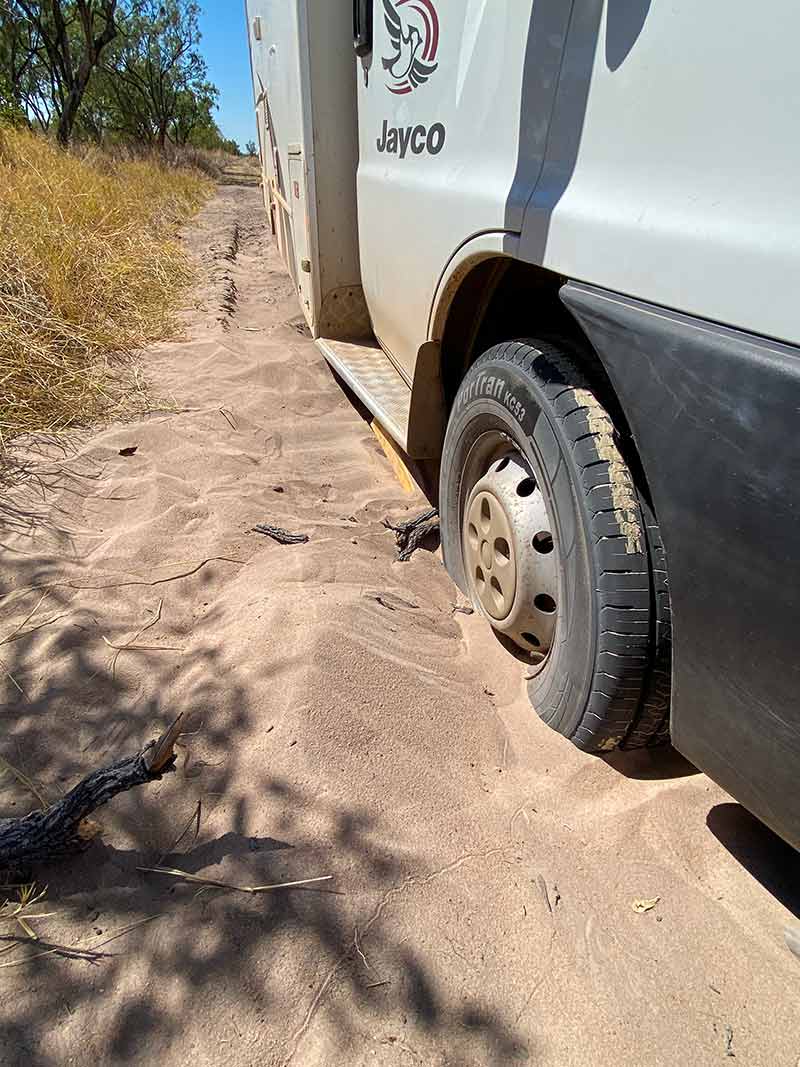 For a couple who don’t go offroad, how did we end up in this predicament? How stupid to have followed this track so far. But how stupid to point people this way. Why have a sign to a tourist spot that is not there? And how stupid not to have a ‘4WD-only’ or ‘private property’ sign at the start of the track.
For a couple who don’t go offroad, how did we end up in this predicament? How stupid to have followed this track so far. But how stupid to point people this way. Why have a sign to a tourist spot that is not there? And how stupid not to have a ‘4WD-only’ or ‘private property’ sign at the start of the track.
Hours pass. No-one shows. We call the emergency line again.
This time, a young voice chastises us. We must have sounded too calm.
“You shouldn’t call this number unless it’s an emergency,” she says.
So, we do what we’ve been told not to do and tell her the whole story.
She agrees we’re in a spot of bother and says she’ll get someone to call us back. Which is impossible because it’s the emergency number.
We finally get through to Sgt George, but he has more bad news.
“The recovery team couldn’t find you,” he says. “They went to the historic hospital site. You do know it’s on the other side of the road.”
LESSON 4
Read tourist road signs carefully
Oops. That’s the polite version of what came out of my mouth. I’m sure I didn’t read that sign wrong. But we’ll deal with that later.
“The team used your GPS coordinates, but they couldn’t get down the track in the tow truck,” he adds. “They will give it another crack tomorrow.”
Tomorrow? I ask Sgt George if he knows who the landowner is. Could he help?
I don’t know why that gem of commonsense didn’t surface earlier.
We have pinpointed our location on an unsealed track heading west to Western Cedar Creek.
“Call me back in 30 minutes.”
We go through the calling rigmarole again and Sgt George is beaming down the line.
“Noel Mitchel from Birdum Creek Station is coming to help,” he says. “He’s only about 20 minutes away.”
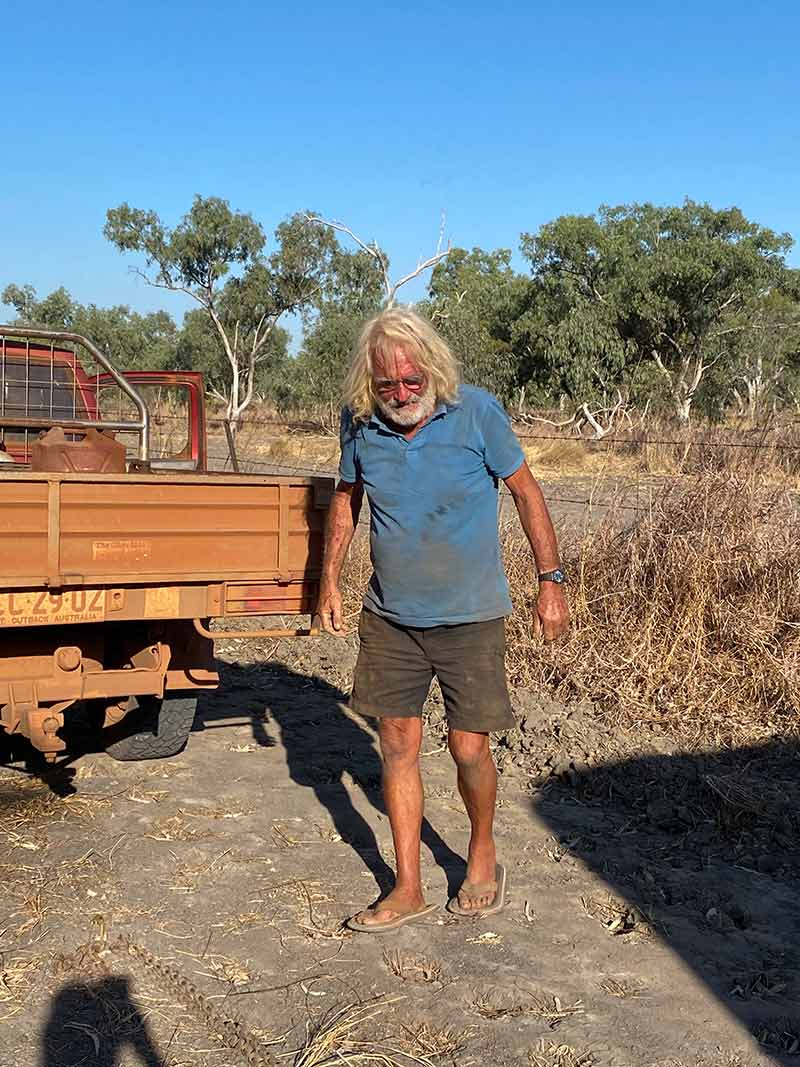
I nearly cry. Mind you, we’re better off than others might have been. We have plenty of food and water. It’s just not the ideal free camp. We’re not ‘free’ by any means.
Twenty minutes later, coming down the sandy track ahead of us, is a vehicle. It’s the oldest bucket of bolts and the best-looking Nissan Navara farm ute you can imagine. And Noel. What a champion. He must have been shaking his head when he saw us.
Turns out the track we are on leads to his station… just 100m along is the gate. And this is the fourth time this year he’s had to get someone out of a ditch.
Noel grabs a snatch strap and a chain out the back of the ute and tries to attach it to the front of our motorhome. It’s too big. So he hops in his Nissan and drives up and on through the scrub we couldn’t attempt and comes out behind us.
“I’ll pull you out backwards, you get a good run up and plough through the sand, and keep going to the gate,” he says.
“Okay…” is all we can manage, not at all confident.
With sand spurting all over, we’re dragged out and on to hard ground. We charge towards the gate. But a disused railway line gets in the way. Bogged again.
This time, Noel has to go back home to grab a D-shackle to pull us out forwards.
But we’re not worried anymore. Our knight in thongs and shorts and riding his trusty, dusty steel steed is coming back to save us.
Between us and that gate are four more bog sites. The next tow takes us into his property and through four more gates that have to be open and closed. Each time we have to be dragged along.
Through a haze of dust with the sun setting behind old gums and enormous termite mounds, we finally make it to his house. His head is bleeding where he knocked it under the RV. But he won’t let me tend to it.
“Just out that last gate, take the road to the right and it’ll lead to the main road,” Noel says. “Larrimah is only about 5km down the road.”
This time it’s a good dirt road; solid and wide.
The ramshackle Larrimah Pub with its weird Pink Panther statue downing a beer has never looked so inviting. News has already reached the caravan park.
As he waved us off down the track, I’m sure he was shaking his head, grumbling about silly tourists. But he wouldn’t take more than a ‘thank you’.
We tried to give him the money the ‘recovery team’ wanted but he wouldn’t have a bar of it. He wouldn’t tell me his ‘local’ so I could leave a bar tab, or where he shopped so I could pay it forward.
He was just happy we were safe and driving away… far away.
As for that tourist sign, it was on the left-hand side of the road, making it look like we had to pull in to get to the historic No. 45 Hospital. But we missed the fact that it was cut roughly in the shape of an arrow pointing to a track on the other side of the highway.


